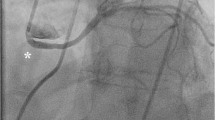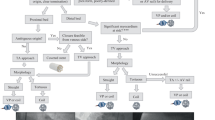Abstract
Improved surgical and medical therapy have prolonged survival in patients with congenital heart disease (CHD) such that general medical conditions like coronary artery disease (CAD) are now the main determinants of mortality. A summary of the association of CAD with CHD, as well as a discussion of the radiologic evaluation of the coronary arteries in adults with CHD is described herein. Cross sectional imaging to evaluate CAD in adults with CHD should follow the same appropriateness criteria as gender and aged matched patients without CHD. Coronary CT imaging may be particularly valuable in evaluating the coronary arteries in this patient population as invasive coronary angiography may prove challenging secondary to complicated or unconventional anatomy of the coronary arteries. Further, typical methods for evaluating CAD such as stress or echocardiography may be impractical in adults with CHD. Finally, delineating the anatomic relationship of the coronary arteries and their relationship with the sternum, chest wall, conduits, grafts, and valves is highly recommended in patients with CHD prior to reintervention to avoid iatrogenic complications.





Similar content being viewed by others
References
Reller MD et al (2008) Prevalence of congenital heart defects in metropolitan Atlanta, 1998–2005. J Pediatr 153(6):807–813
Marelli AJ et al (2014) Lifetime prevalence of congenital heart disease in the general population from 2000 to 2010. Circulation 130(9):749–756
Opotowsky AR, Siddiqi OK, Webb GD (2009) Trends in hospitalizations for adults with congenital heart disease in the US. J Am Coll Cardiol 54(5):460–467
Billett J et al (2008) Trends in hospital admissions, in-hospital case fatality and population mortality from congenital heart disease in England, 1994–2004. Heart 94(3):342–348
Afilalo J et al (2011) Geriatric congenital heart disease: burden of disease and predictors of mortality. J Am Coll Cardiol 58(14):1509–1515
Pillutla P, Shetty KD, Foster E (2009) Mortality associated with adult congenital heart disease: trends in the US population from 1979 to 2005. Am Heart J 158(5):874–879
Kavey RE et al (2006) Cardiovascular risk reduction in high-risk pediatric patients: a scientific statement from the American Heart Association Expert Panel on Population and Prevention Science; the Councils on Cardiovascular Disease in the Young, Epidemiology and Prevention, Nutrition, Physical Activity and Metabolism, High Blood Pressure Research, Cardiovascular Nursing, and the Kidney in Heart Disease; and the Interdisciplinary Working Group on Quality of Care and Outcomes Research: endorsed by the American Academy of Pediatrics. Circulation 114(24):2710–2738
Perloff JK (2004) The coronary circulation in cyanotic congenital heart disease. Int J Cardiol 97(Suppl 1):79–86
Fyfe A et al (2005) Cyanotic congenital heart disease and coronary artery atherogenesis. Am J Cardiol 96(2):283–290
Duffels MG et al (2010) Atherosclerosis in patients with cyanotic congenital heart disease. Circ J 74(7):1436–1441
Angelini P, Velasco JA, Flamm S (2002) Coronary anomalies: incidence, pathophysiology, and clinical relevance. Circulation 105(20):2449–2454
Roberts WC (1986) Major anomalies of coronary arterial origin seen in adulthood. Am Heart J 111(5):941–963
Guerri-Guttenberg RA et al (2013) Transforming growth factor β1 and coronary intimal hyperplasia in pediatric patients with congenital heart disease. Can J Cardiol 29(7):849–857
Levy D et al (1990) Prognostic implications of echocardiographically determined left ventricular mass in the Framingham Heart Study. N Engl J Med 322(22):1561–1566
Roifman I et al (2012) Coarctation of the aorta and coronary artery disease: fact or fiction? Circulation 126(1):16–21
Freed MD et al (1979) Exercise-induced hypertension after surgical repair of coarctation of the aorta. Am J Cardiol 43(2):253–258
Legendre A et al (2003) Coronary events after arterial switch operation for transposition of the great arteries. Circulation 108(Suppl 1):II186–II190
Pedra SR et al (2005) Intracoronary ultrasound assessment late after the arterial switch operation for transposition of the great arteries. J Am Coll Cardiol 45(12):2061–2068
Diller GP et al (2005) Exercise intolerance in adult congenital heart disease: comparative severity, correlates, and prognostic implication. Circulation 112(6):828–835
Tutarel O, Gabriel H, Diller GP (2013) Exercise: friend or foe in adult congenital heart disease? Curr Cardiol Rep 15(11):416
Swan L, Hillis WS (2000) Exercise prescription in adults with congenital heart disease: a long way to go. Heart 83(6):685–687
Tutarel O (2014) Acquired heart conditions in adults with congenital heart disease: a growing problem. Heart 100(17):1317–1321
Moons P et al (2006) Prevalence of cardiovascular risk factors in adults with congenital heart disease. Eur J Cardiovasc Prev Rehabil 13(4):612–616
Bailliard F, Hughes ML, Taylor AM (2008) Introduction to cardiac imaging in infants and children: techniques, potential, and role in the imaging work-up of various cardiac malformations and other pediatric heart conditions. Eur J Radiol 68(2):191–198
Boiselle PM et al (2013) Expert opinion: computed tomography versus magnetic resonance imaging for young adults with congenital heart disease. J Thorac Imaging 28(6):331
Ferreira PF et al (2013) Cardiovascular magnetic resonance artefacts. J Cardiovasc Magn Reson 15:41
Choi TY et al (2011) Radiation dose reduction with increasing utilization of prospective gating in 64-multidetector cardiac computed tomography angiography. J Cardiovasc Comput Tomogr 5(4):264–270
Warnes CA et al (2008) ACC/AHA 2008 guidelines for the management of adults with congenital heart disease: a report of the American College of Cardiology/American Heart Association Task Force on Practice Guidelines (Writing Committee to Develop Guidelines on the Management of Adults With Congenital Heart Disease). Developed in Collaboration With the American Society of Echocardiography, Heart Rhythm Society, International Society for Adult Congenital Heart Disease, Society for Cardiovascular Angiography and Interventions, and Society of Thoracic Surgeons. J Am Coll Cardiol 52(23):e143–e263
Shi H et al (2004) Multislice CT imaging of anomalous coronary arteries. Eur Radiol 14(12):2172–2181
Milano AD et al (2003) Fate of coronary ostial anastomoses after the modified Bentall procedure. Ann Thorac Surg 75(6):1797–1801 (discussion 1802)
Perloff JK, Warnes CA (2001) Challenges posed by adults with repaired congenital heart disease. Circulation 103(21):2637–2643
Edwin F et al (2010) Permanent complete heart block following surgical correction of congenital heart disease. Ghana Med J 44(3):109–114
Walsh MA, Noga M, Rutledge J (2015) Cumulative radiation exposure in pediatric patients with congenital heart disease. Pediatr Cardiol 36(2):289–294
Greenberg SB et al (2012) Computed tomography angiography in children with cardiovascular disease: low dose techniques and image quality. Int J Cardiovasc Imaging 28(1):163–170
Elahi M et al (2005) Direct complications of repeat median sternotomy in adults. Asian Cardiovasc Thorac Ann 13(2):135–138
Holst KA et al (2011) Risk factors and early outcomes of multiple reoperations in adults with congenital heart disease. Ann Thorac Surg 92(1):122–128 (discussion 129-30)
Morishita K et al (2003) Three or more median sternotomies for patients with valve disease: role of computed tomography. Ann Thorac Surg 75(5):1476–1480 (discussion 1481)
Cook SC, Raman SV (2007) Unique application of multislice computed tomography in adults with congenital heart disease. Int J Cardiol 119(1):101–106
Yoshioka I et al (2009) Tagged cine magnetic resonance imaging with a finite element model can predict the severity of retrosternal adhesions prior to redo cardiac surgery. J Thorac Cardiovasc Surg 137(4):957–962
Mulligan SA, Soto B, Nath PH (1987) Usefulness of computed tomography in preoperative assessment of resternotomy after ascending aortic aneurysm resection or after cardiac ventricle to pulmonary conduit insertion. Am J Cardiol 60(8):739–743
Sridharan S et al (2006) Images in cardiovascular medicine. Transcatheter right ventricular outflow tract intervention: the risk to the coronary circulation. Circulation 113(25):e934–e935
Nordmeyer J et al (2009) Effective transcatheter valve implantation after pulmonary homograft failure: a new perspective on the Ross operation. J Thorac Cardiovasc Surg 138(1):84–88
Khambadkone S (2012) Percutaneous pulmonary valve implantation. Ann Pediatr Cardiol 5(1):53–60
Author information
Authors and Affiliations
Corresponding author
Ethics declarations
Conflict of interest
The authors declare that they have no conflict of interest.
Human and animal rights
No research involving human participants or animals was conducted.
Rights and permissions
About this article
Cite this article
Valenzuela, D.M., Ordovas, K.G. Radiologic evaluation of coronary artery disease in adults with congenital heart disease. Int J Cardiovasc Imaging 32, 13–18 (2016). https://doi.org/10.1007/s10554-015-0760-5
Received:
Accepted:
Published:
Issue Date:
DOI: https://doi.org/10.1007/s10554-015-0760-5




